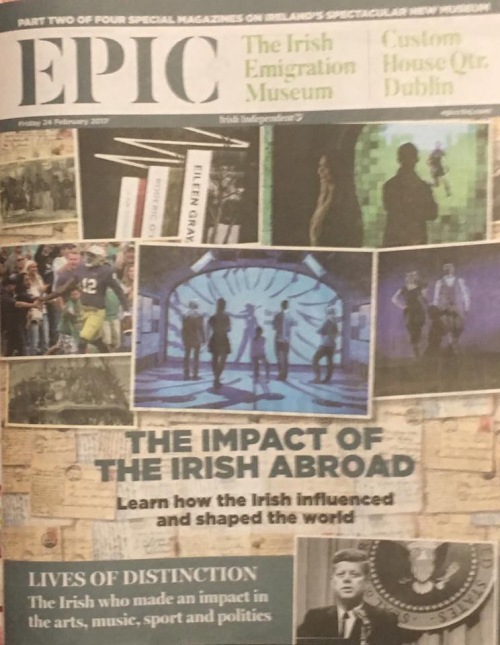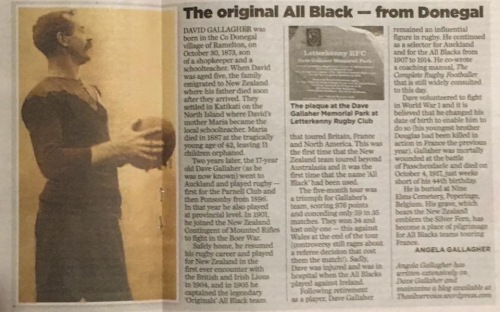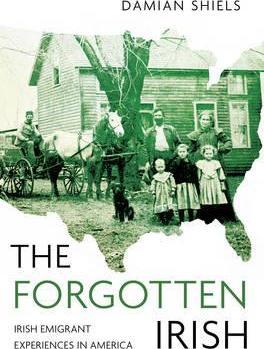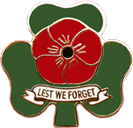Today, Remembrance Sunday, the Irish Taoiseach (Prime Minister) and Tánaiste (Deputy Prime Minister) attended Remembrance services in Northern Ireland for the first time. Today too, the President of Ireland, Michael D Higgins will attend the annual commemoration of the War Dead at St Patrick’s Cathedral in Dublin.
Many ‘ordinary’ people of Ireland are passionate about NOT commemorating this day, in some cases probably because of a lack of understanding of the social conditions at the time,that compelled Irish men and boys in their tens of thousands to go to war. It is true that after the conflict, many families were ashamed of relatives returning from the War, but as this article in yesterday’s Irish Times demonstrates, things are changing. Those who had been ‘airbrushed’ out of Irish family history are now being honoured and remembered with pride.
The wearing of a Poppy in Ireland remains controversial in 2012 as demonstrated by this article from The Irish Independent on the reaction to a Poppy wearer in the streets of Dublin . The reaction of the Chelsea Football supporter in this item is interesting – sadly he probably verbalized what many think in private. Why can we not treat the wearing of a Poppy as a memory of men who died in awful circumstances, and not as a symbol of British Imperialism?
I recently discovered the website of the Limerick Branch of the Royal British Legion on which they have displayed a new Irish Poppy badge – a poppy overlaid on a shamrock. It’s a truly beautiful emblem and having worn it for the past few days myself, it has elicited a very positive response. I have no doubt that it will become a popular emblem for those who wish to commemorate the sacrifices of people from this island who put themselves in harm’s way in the most horrific circumstances. They deserve to be remembered.
Last year I attended a Conference in Ennis that resulted in the following blog post – which I reprint here in tribute and in memory of all those who died .
On Saturday October 1st 2011 at the Clare Roots Genealogy and Family History Conference, historian Liam Curran delivered what was to me a fascinating presentation on ‘The Irish Soldier in the British Army in the First World War’. Liam presented an account of the horrors of war that featured real people, including members of his own family, who lived and loved not far from where I now live; real people who died in the most horrific of circumstances – sons, brothers, uncles, fathers.
During that presentation we saw a very famous painting entitled ‘The Last Absolution of the Munsters’ by the war artist, Matania.
 ‘On Saturday evening the 8th May 1915, prior to the battle in the Aubers Ridge area, the 2nd Battalion Royal Munster Fusiliers marched through Rue du Bois, about one mile out from the town of Neuve Chapelle in Belgium. The Battalion halted near a wayside shrine. Moving off the road they formed up in their respective Companies, ‘A’, ‘B’, ‘C’ and ‘D’. In front of each Company was a green flag with the Irish Harp and word “Munster” embroidered on it’
‘On Saturday evening the 8th May 1915, prior to the battle in the Aubers Ridge area, the 2nd Battalion Royal Munster Fusiliers marched through Rue du Bois, about one mile out from the town of Neuve Chapelle in Belgium. The Battalion halted near a wayside shrine. Moving off the road they formed up in their respective Companies, ‘A’, ‘B’, ‘C’ and ‘D’. In front of each Company was a green flag with the Irish Harp and word “Munster” embroidered on it’
Most if not all the men depicted here are from Munster. The priest on horseback who gave a general absolution to these men was Francis Gleeson, one of 13 children from Templemore, Co Tipperary. On the extreme right is Regimental Sergeant Major John Ring born in Bandon. Also here are many men from Clare. The second mounted figure is 40-year old Colonel Victor Rickard, husband of Louise Moore from Mitchelstown, Co. Cork, whose father founded the Cork Historical and Archaeological Society and was a Protestant Home Ruler. She herself wrote articles for the Cork Examiner Newspaper.
At dawn on 9th May, just hours after the general absolution, these Irish men came out of their trenches. Within hours, 151 of them lay dead, including the Commanding Officer Rickard, and 16 men from Clare.
Just one of a number of Irish Regiments, the Munster Fusiliers consisted in the main of Munster men – mainly from Clare, Kerry, Cork and Tipperary. They fought and died in their hundreds in various areas of conflict during their long history including Afghanistan 1839, Burma 1852, The Crimea, the Boer War. It is reckoned that about a quarter of a million Irish men were involved in the First World War. They endured the horror of the killing fields of the Western Front, often cold and often hungry, surrounded by the stench of death, hearing the screams of the dying, with rats eating their feet. They were slaughtered, drowned and maimed in Gallipoli and in many places whose names they could not pronounce.

Text from Fr Gleeson’s Diary entry 10 May 1915 as inscribed at the Messines Irish Peace Park.
Growing up and educated in Ireland in the 1960s, I was never aware of the tens of thousands of our countrymen who fought and died in horrific conditions in many theatres of war down the centuries. These people had effectively been wiped from the history that we were taught in schools, wiped from our national memory, wiped from our very DNA.
The truth is that most were volunteers. The truth is that, fired up by calls by Irish Nationalists like John Redmond, who claimed that ‘Ireland’s highest interests’ lay ‘in the speedy and overwhelming victory of England and the Allies’ they volunteered in their droves; the truth is that many went because they needed the money for their families; the truth is that many went because they belonged to large families with low-income and it would be one less mouth to feed. Undoubtedly some also went in search of adventure and perhaps also to escape issues at home.
The First World War was the war in which most Irish lives were lost and in which the Irish performed amazing acts of courage and bravery. However, when the survivors returned they were shunned and met with hostility and even physical violence. The honour with which they had departed was in stark contrast to the changed circumstances when they returned. Ireland had staged an uprising against British rule at Easter 1916 and the Ireland to which they returned was one with a new sense of nationalism and a different set of values.
We in Ireland have come a long way in redressing the airbrushing of our past. President Mary Robinson was the first Irish President to wear a poppy on November 11th each year and President McAleese has kept up her predecessor’s practice of attending the remembrance Sunday services in St Patrick’s Cathedral in Dublin. President Mary McAleese also stood shoulder to shoulder with the Queen of England at the opening of the Island of Ireland Peace Park in Mesen (Messines) Belgium on 11 November 1998. We still, however, have a way to go.

Poppy Field on the Somme. Picture from the BBC.

In Flanders Fields – the iconic poem by John McCrae, MD, (1872 – 1918) Canadian Army.
‘If ye break faith with us who die,
We shall not sleep, though poppies grow in Flanders fields’
I will not break faith and will proudly wear a red poppy on 11 November 2011 to honour all Claremen, all Munster men, all Irishmen who made the ultimate sacrifice.
Epilogue
Fr. Gleeson volunteered for a second time and returned to parish work in Dublin where he died in 1959. He is buried in Castlelough, Co Tipperary.
Sgt Major John Ring served for 5 years in France and repeatedly refused promotion to stay with his battalion. He retired to Limerick and died in 1960. He is buried in Mount St Lawrence Cemetery.
References
Royal Munster Fusiliers Association
Royal Munster Fusiliers
http://www.limerickcity.ie/media/Media,3979,en.pdf
Liam Curran’s lecture – which also included an account of the Munsters in Gallipoli, notably those who landed from the steamer ‘River Clyde’ – is available on DVD from Clare Roots here

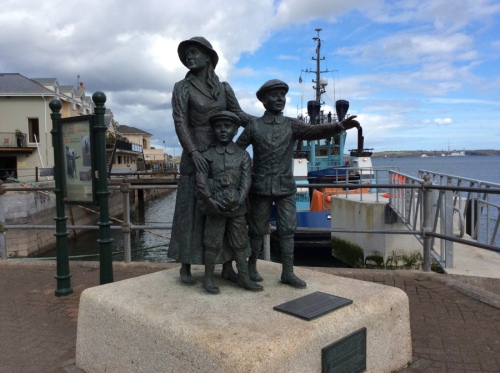

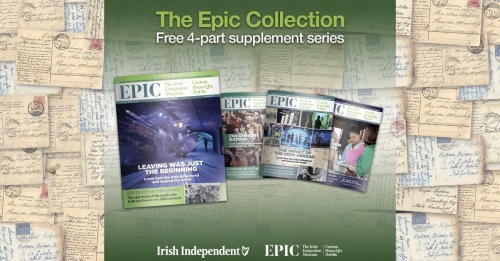 EPIC
EPIC 